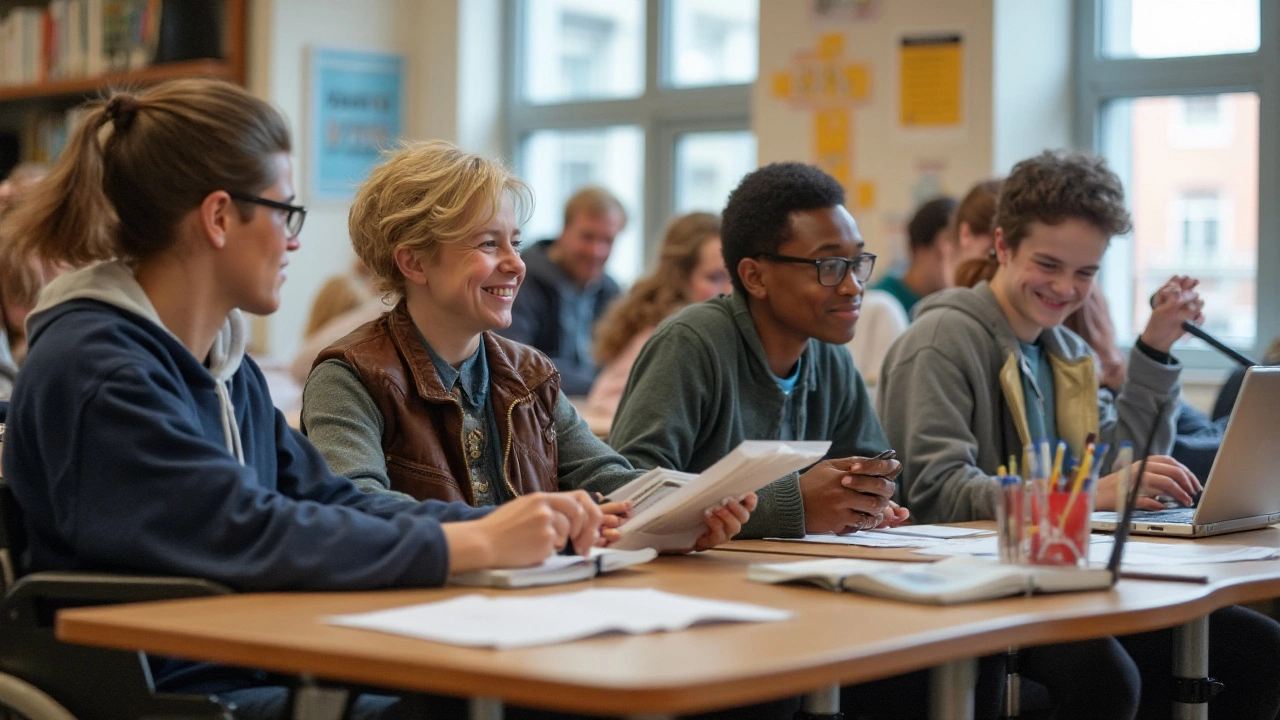In today's educational landscape, accommodating the diverse needs of students is more than a nicety—it's a necessity. Schools and universities have increasingly recognized the importance of creating an inclusive environment to support all learners, regardless of their personal challenges or backgrounds. It's about breaking down barriers that could hinder someone from achieving their full potential.
Student accommodations are designed to provide tailored support to those who need it, whether they are dealing with physical disabilities, learning disorders, or other significant challenges. By understanding and implementing these accommodations, educational institutions can create a more equitable and successful learning environment for everyone. Let's delve into why these accommodations are so crucial and the impact they can have on student achievement.
- The Purpose of Student Accommodations
- Types of Accommodations Offered
- Legal Frameworks and Policies
- The Impact on Student Success
- Challenges in Implementation
- Future Trends in Student Accommodations
The Purpose of Student Accommodations
Student accommodations serve a vital role in leveling the educational playing field, making it accessible for everyone to thrive academically. The primary purpose of these accommodations is to ensure that every student has an equitable opportunity to succeed, regardless of their individual challenges. This involves addressing a wide array of needs, from physical disabilities to learning differences, and other situational hurdles that might impede educational progress. When schools tailor their environments and teaching methods through student accommodation, they are helping students leverage their strengths and mitigate their limitations, thus promoting a more inclusive academic experience.
Imagine a classroom where every student, regardless of their physical or cognitive abilities, can actively participate and feel valued. This is precisely what effective education support services aim to achieve. They are designed not just to meet the basic educational needs, but also to nurture the unique talents and capabilities of each student. By offering things like assistive technology, tailored instructional strategies, and modified assessments, institutions foster an environment that champions diversity and enables all students to engage fully.
"Education is the most powerful weapon you can use to change the world," Nelson Mandela once said. This belief underscores why it's crucial that everyone has fair access to education, which student accommodations help facilitate.Beyond academic adjustments, accommodations may also include support services such as counseling and accessibility resources, ensuring that students are holistically supported to pursue their ambitions unfettered by unnecessary obstacles. Such measures reflect a recognition of the diverse needs within the student body and a commitment to addressing these proactively through well-thought-out accommodations.
Data presented in reports show promising trends: universities that proactively implement educational success strategies through accommodations often report higher retention rates among students with disabilities. According to the National Center for Education Statistics, in the U.S., students receiving support services graduate at a rate nearly 12% higher than those who do not, highlighting the significance of accommodations in student achievement. It's clear that these efforts do not merely benefit individuals with immediate needs, but enhance the learning environment for all by cultivating an atmosphere of empathy, inclusivity, and innovation.
Types of Accommodations Offered
When we talk about student accommodation, it encompasses a variety of supports tailored to meet students' individual needs. These accommodations aim to create a level playing field, allowing each student to access education equitably. The range of accommodations offered can be quite broad, but understanding their nuances is essential for boosting educational success. For instance, modifications might be made to teaching methods, academic requirements, or the physical environment to better suit students' needs.
A common form of accommodation is extended time for tests and assignments. This particularly benefits students who require additional time to process information or who might be dealing with anxiety conditions. Another frequent accommodation involves the offering of alternative formats for learning materials. This could include providing textbooks in Braille or audio formats for visually impaired students, ensuring they can engage with the same content as their peers.
In some cases, accommodations may involve ensuring physical access to facilities. This includes installing ramps or elevators in buildings, or creating dedicated seating in classrooms to better cater to students with mobility challenges. Such measures are vital in providing an equal learning environment for everyone. According to a survey by the National Center for Education Statistics, about 11% of students in the US require some form of accommodation to participate fully in school activities.
"Education is the most powerful weapon which you can use to change the world." — Nelson Mandela
Another form of accommodation involves the use of technological aids. This might include speech-to-text programs, text-to-speech devices, or other assistive technologies that facilitate learning for students with specific disabilities. These tools can be game-changers for students who struggle with traditional methods of learning and demonstrate how well-thought-out accommodations can bridge gaps in access and achievement.
Some students benefit from having access to structured support systems such as peer tutoring or mentoring programs. These arrangements can help students stay organized and motivated, providing emotional and academic support. It's important to note that the implementation of these accommodations often requires careful planning and cooperation between educators, parents, and disability services.
Lastly, it’s crucial to recognize the role of educators in this setup. Teachers trained to recognize and support diverse learning needs can personalize learning experiences for students, further ensuring success. Institutions might offer professional development workshops to enable this, promoting a wider understanding and acceptance of accommodations within school communities. After all, preparing an inclusive academic environment doesn’t just benefit students in need of support; it's a collective gain for educational success across the board.

Legal Frameworks and Policies
To fully appreciate the significance of student accommodation services, one must first understand the extensive legal frameworks and policies that underpin them. These regulations serve as the backbone of inclusivity in educational settings, ensuring that every student has equal access to learning opportunities. In many countries, legislation like the Americans with Disabilities Act (ADA) and the Individuals with Disabilities Education Act (IDEA) in the United States, or the Equality Act 2010 in the United Kingdom, play a pivotal role in compelling educational institutions to cater to the diverse needs of students. These laws typically require schools and universities to provide necessary adjustments or 'accommodations' that level the playing field for all learners.
The impact of such policies cannot be overstated. For instance, the ADA has been instrumental in transforming campus life for students with disabilities, mandating everything from physical modifications of school buildings to the implementation of technology-based accessibility solutions. This legal framework ensures that doors—literal and metaphorical—are open to students who might otherwise face insurmountable barriers. An essential aspect of these regulations is their adaptability, as they often leave room for interpretation to meet specific student needs. This flexibility is crucial, as it allows accommodations to be as bespoke and responsive as necessary within each unique educational context.
According to the National Council on Disability, nearly one in five Americans has a disability, a statistic that underscores the importance of these legal protections. Educational policies are not only about compliance; they are about fostering an environment where every student feels valued and supported. The challenge often lies in balancing regulatory compliance with the actual implementation of effective support. Schools and universities need to continually assess their environments, considering whether their efforts to provide academic support are truly meeting the intent of the laws.
"Education is not preparation for life; education is life itself." - John Dewey
Legal frameworks also extend to the provision of resources and training for faculty and staff, equipping them with the necessary tools to support and advocate for students in need. By investing in such infrastructural and human resources, institutions send a powerful message about their commitment to inclusivity. However, establishing these protocols is not without its hurdles. Issues such as funding constraints, limited awareness, and varying interpretations of what constitutes adequate support often present significant challenges.
Looking at global perspectives, contrasting policies like those found in European educational systems, which often provide comprehensive guidelines and funding models for implementing accommodations, offer valuable lessons. These international approaches highlight the importance of robust policy implementation supported by government initiatives. It raises an essential question: Might adopting similar practices enhance the educational success of a broader range of students in other parts of the world? When we view educational success through the lens of legal and policy frameworks, it's evident that these structures not only guard against discrimination but also serve as vital conduits for achieving true equality in education.
The Impact on Student Success
Embracing student accommodation measures significantly enhances the academic experiences and outcomes for students who require them. These accommodations directly contribute to leveling the playing field, ensuring that every learner can access education on equal footing. Consider a student with dyslexia; traditional testing methods might not accurately reflect their knowledge or potential. By introducing alternatives such as extended time or oral exams, we allow them to demonstrate their true abilities. This approach applies not just to learning disabilities, but also to students facing physical, emotional, or psychological barriers that might impede their educational journey.
The positive effects on student success are manifold. Studies have shown that students who receive proper accommodations are more likely to stay in school and succeed academically. According to research conducted by the U.S. Department of Education, students who utilized these services were more likely to persist in higher education environments and completed their courses at a rate significantly higher than those who did not receive such support. These statistics serve as a powerful testament to the transformative power of personalized educational strategies. Imagine the increase in self-confidence and motivation as individuals begin to achieve milestones previously thought unattainable.
It’s essential, too, to consider the socio-cultural impacts of these practices. By fostering an inclusive environment, educational institutions not only enrich individual lives but also cultivate a diverse community that benefits everyone involved. Accommodations signal a commitment to diversity and representation, encouraging all students to feel valued and understood. This atmosphere empowers students to engage more fully, participate in collaborative projects, and develop interpersonal skills that are critical for their future careers. Indeed, as Dr. Karen Pollock, a noted expert in education psychology, once stated:
“Accommodations are not just a support mechanism, they are an expression of genuine inclusivity paving a path to mutual understanding and respect.”
Ultimately, the real-world success of implementing such accommodations depends on the collective effort of educators, administrators, and students themselves. It’s a partnership where every voice matters and each adjustment made in the classroom translates to real-world skills. Equipping students with the tools they need to overcome barriers builds resilience, a trait deeply crucial in both academic settings and life beyond school. As we progress, embracing innovative accommodations can only expand opportunities, ensuring that education remains a vibrant and accessible endeavor for all.

Challenges in Implementation
Implementing student accommodation measures can be fraught with various challenges that educational institutions need to navigate carefully. First of all, there is the issue of awareness—both among educators and students themselves. Many students might not even realize they qualify for accommodations, or they may be unaware of how to advocate for their own needs. This is compounded by a lack of training for faculty and staff, who may not fully understand the legal requirements or how to support students effectively. Addressing awareness and training is crucial for fostering an environment where accommodations are not viewed as special privileges, but as necessary support systems promoting equal opportunity for all learners.
Another significant hurdle is funding. Schools and universities often operate within tight budgets, and allocating resources for accommodation services can be challenging. Ensuring accessibility may require substantial investments in infrastructure or technology, and not all institutions are equipped with the financial resources needed. This economic barrier necessitates strategic planning and potentially seeking external funding, yet the commitment to provide a comprehensive support system is crucial to avoid leaving students behind due to fiscal constraints.
Managing the logistics of accommodations poses its own set of problems. Every student's needs are unique, requiring personalized accommodations that need to be seamlessly integrated without disrupting the core educational environment. This involves coordinating between different departments and ensuring that faculty, administration, and support staff are all on the same page. Miscommunication between parties can result in incomplete or incorrectly implemented accommodations, thereby failing the very students these measures are meant to assist.
"Inclusivity in education is not just about setting quotas on diversity; it's about creating an adaptive learning environment that acknowledges and supports every student's potential." - Education Equality Advocate.
The evolving landscape of education, especially with technological advancements, adds yet another layer of complexity to the implementation of accommodations. As digital learning platforms and remote education become more prevalent, ensuring these technologies are accessible to all students is vital, yet still not guaranteed. Institutions need to constantly update their systems to not only incorporate the latest accessible technologies but also ensure they work across various needs and disabilities. This rapid pace of change can be overwhelming and requires constant evaluation and adjustment.
There can also be resistance, either from within the institution or from students themselves. Some faculty may see accommodations as an additional burden rather than a fundamental part of teaching, while some students might feel stigmatized by having to use these services. Changing perceptions and fostering an understanding that accommodations are a bridge to equity rather than an indicator of inadequacy is an ongoing battle. Engaging the school community through dialogues about inclusivity and sharing success stories can help shift these mindsets.
Finally, navigating the legal aspects of accommodations is always a significant concern. Institutions must stay informed about laws and regulations that govern student accommodations to ensure compliance and avoid potential legal repercussions. Misinterpretation of these regulations can lead to inadequate services or even discrimination, with serious consequences. Schools need dedicated personnel to oversee compliance and ensure that all practices are inclusive and lawful.
Future Trends in Student Accommodations
As we look to the future of education, student accommodations are evolving to embrace new technologies, changing societal norms, and an increasing understanding of diverse learning needs. The rise of digital tools and platforms is playing a crucial role in how accommodations are being tailored to fit individual student requirements. For instance, many schools are now utilizing artificial intelligence to create personalized learning plans that adapt to a student's pace and style of learning, thereby providing a customized educational experience. This not only makes learning more accessible but also enhances engagement and retention by addressing each student's unique learning process.
There's also a growing emphasis on mental health support within educational settings. Schools are incorporating mental health days into their programs, recognizing that mental well-being plays a significant role in a student’s ability to learn and thrive. This approach is complemented by the presence of on-campus counseling services and stress-relief activities, which help to create a holistic support system for students. In a recent survey by the National Alliance on Mental Illness, it was found that 64% of college students with mental health disorders drop out, underlining the importance of these future-focused strategies.
Student accommodation services are also expanding beyond traditional adjustments, such as extended time for tests or alternate formats for materials. Many institutions are now exploring ways to make all aspects of campus life more inclusive, from housing arrangements that cater to diverse needs and strict dietary requirements to recreational activities that can adapt to different physical abilities. These shifts highlight a broader commitment to inclusivity and diversity within educational environments.
One fascinating development is the integration of virtual and augmented reality in educational settings, offering immersive experiences that can greatly benefit students with learning disabilities. These tools can simulate real-life scenarios where students can learn in a controlled, repeatable environment. For example, medical students can perform virtual surgeries to practice their skills without any risk. According to a report by MarketsandMarkets, the education sector's adoption of AR and VR technologies is expected to grow significantly, potentially transforming how accommodations are delivered to students.
Moreover, legislative changes are poised to play a significant role in shaping the future of student accommodation. As greater awareness and understanding grow, more comprehensive policies are likely to be implemented at both national and international levels. These policies will continue to push schools toward providing necessary support services that are not only legally mandated but intrinsically vital for equal educational access. In an enlightening quote from Education Secretary Miguel Cardona, he states, “To be effective educators, we must honor and understand the individualized needs of our students. It's not just about accommodating—we're ensuring opportunity.”
In conclusion, the landscape of student accommodations is one of continuous development, driven by technological advancements, societal changes, and a deepening recognition of diverse student needs. As these trends unfold, they offer promising potentials to enrich educational environments and elevate the learning experiences of university students across the globe.
